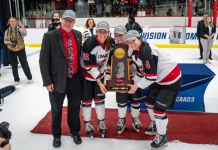It’s not easy finding anything new to write about the movie “Miracle,” since so much great stuff has already been written. But I’m a writer, and that’s what I do.
The biggest miracle about “Miracle” was that Disney didn’t screw it up. There’s no way a movie like this is going to be a great film in the world of cinema. The story, of the U.S. Olympic Team’s gold medal in 1980 and its driven coach Herb Brooks, for as spine-tingling as it is, is really pretty basic and corny as stories go. And in order to capture the realism, most of the parts were played by hockey players who are acting wannabes, instead of vice-versa.
But considering the material, and considering the many ways it could have been a disaster (Disney-fied), it was a rousing success. Admittely, I’m a cryer in movies anyway — yeah, I cried when Old Yeller died (actually, I cried during Bill Murray’s ‘Old Yeller’ speech in Stripes, the best speech in an army movie in cinema history) — but I was teary-eyed throughout.
Disney could have had as popular a movie had it been cheesed up with melodrama, starring Rob Lowe types who can’t skate. But by focusing on hyper-realism, it went the only way it could to make it a true credible film. Sure the story itself is simplistic, but as my favorite critic Roger Ebert likes to say, “It’s not what a movie is about, but how it’s about it.”
For the general populace, it’s a simple story about a great moment. For the general sports fan, it’s great to see such a well-known story done well. For the college hockey fanatic, it’s that much cooler, seeing all the people and places you know about referred to in an actual film. That’s just cool.
Of course, the fanatic also finds things to nitpick. Tom Douglis, in his review for USCHO, found a few. I’ve found a few more. First, however, a comments on one of Tom’s nitpicks:
Tom mentioned that the film misses the fact that Herb Brooks was the third choice. However, the film does make note, when Brooks says he only got the job because two others turned it down.
As for my own nitpicks (and these are the definition of nitpick):
• Ken Morrow is not portrayed with a beard. As one reader pointed out, whether he had a beard or not was actually a point of contention with Brooks. But not a big deal, since you could spend all day if you wanted on little appearance nitpicks.
• It seems to me they got a little melodramatic with Soviet coach Viktor Tikhonov. You think he really fondled his eyebrows and got as flustered as he was made out to be? Though, as Tom points out, they got some important details correct, like the fact that Tikhonov stood in front of the bench.
• Jim Craig tapping the sticks on the posts. Patrick Roy was the first well-known goalie to do this, and next thing you know, every young goalie in the world was emulating it. But Roy first came along in 1986. No prominent goalie, to the best of my knowledge, was tapping his stick on the posts in this era.
• One of the goals, the water bottle comes flying up. I’m all but certain water bottles weren’t on top of the goal cage in those days.
• A few teams, including Finland in the gold medal game, were shown with gray-toned uniforms in places of where the white would be. I noticed this on other teams, but wondered if that’s not just the way it was. But with Finland, I know for sure it wasn’t that way, so I then realized it was wrong. But there had to be a reason the filmmakers did it that way, though I can’t think of one. Maybe it looked better on film to not have white against the white ice.
None of which really bothered me, of course. There were only two things that genuinely did annoy me. Not filming the Soviet game at Lake Placid, and the reenactment of Al Michaels’ calls.
Having been to Lake Placid a half-dozen times, you fall in love with its distinctive charm. To see that game and realize it wasn’t that arena, was distracting. I feel like I was missing out by that not being the setting in the film. Vancouver is a popular movie locale these days, mainly because it’s a great city and it has cheaper labor. Also, Kurt Russell lives up there these days because his son is playing junior hockey in the area. But you’d think Disney could have afforded a week in Lake Placid.
On the Michaels calls, they used the real last 11 seconds of the Soviet game, which is a no-brainer. But otherwise, the calls were mostly re-enacted. As a broadcaster who reveres actual calls, it bugged me. To an extent, I understood the necessity of doing it, to match the footage. And for the most part, it’s tolerable, even though I could tell something didn’t quite sound right. But when it got to Eruzione’s game winner, I definitely noticed it, because that call is so legendary to me. In the real call, leading up to the goal, color man Ken Dryden says “The U.S. team is relying a little too much on Jim Craig, he’s making too many big saves.” And then WHAM! Michaels: “Eruzione, and he scores.” I love that. In the film, they just had Michaels doing all the commentary.
They also cleaned up the pronunciations of the Soviet players’ names. This was most noticeable on Slava Fetisov, which was (wrongly) pronounced “FETA-sov” at the time. As we came to know later, when he entered the NHL in 1987, it’s pronounced “fa-TEE-sov.” The re-enactment used the correct pronunciation, but should have left in the original.
Another observation: This film focused on Ralph Cox as the last cut, which was more or less accurate. “Miracle on Ice,” the 1981 TV miniseries, focused its last cut story on Minnesota’s Les Auge, played by Jerry Houser of “Killer” Carlson/Slapshot (not to mention “The Brady Brides”) fame. Also, the true story of Cox’s cut may have been better. He had broken his ankle during the 62-game pre-Olympic tour, and it wasn’t recovering well enough. He was cut in a hotel room, and, according to Cox, Brooks — who could relate as the last cut of the 1960 team — was crying when he did it.
Of course, they did get the spirit of it right, which is the same way I felt about two other liberties they took with the film. One, the fight between Rob McLanahan and Jack O’Callahan never happened. There was a lot of rough stuff in the 1976 title game between BU and Minnesota, but O’Callahan was never tossed from the game, others were. But the spirit of the East-West rivalry, which was very real, was encapsulized in those scenes, and thus can be forgiven. Similarly, the post-Norway game practice session didn’t end with Eruzione’s hokey “I play for the United States of America” speech, though everything else about it is pretty much correct.
Did anyone catch who the other four players cut were? The ones between when it was 26, and then Auge and Cox as the last two? The film shows Brooks tearing pieces of tape with the players names on it off the blackboard. I may have to wait for the DVD to slow it down and see what those names were.
Finally, I’d wished they actually spent more time emphasizing the impact on the U.S. Obviously, the film touched on the political issues going on in America at the times, and how the country was in the doldrums, besieged by a poor economy, poor standing in the world, and the Soviet threat. The part with President Carter’s “Malaise” speech over the scene of them playing football was quite poignant. But during the Soviet Union game, I’d have loved to see another poignent representation of just how much this meant, and more of the celebration on Main Street in Lake Placid afterwords. I thought it would have summed things up nicely.
(By the way, I’ve said it before and I’ll say it again, there’s no place in history I’d rather have been than Main Street in Lake Placid after that game.)
If you sum up all of these “problems,” however, it doesn’t detract at all from what was a great film. It had the best hockey scenes ever filmed, for sure. And it captured the moment just about as well as it could be captured, all while giving us college hockey fans a lot to say “Cool” about.


